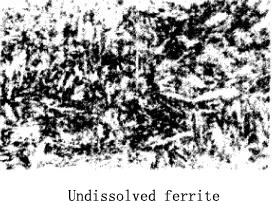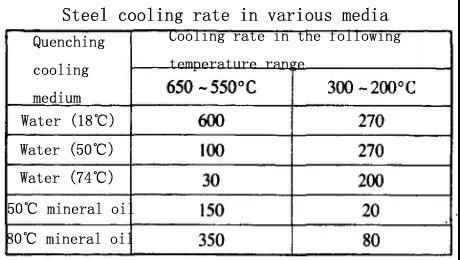Solution of insufficient hardness during die quenching
Time:2020-07-29 09:12:58 / Popularity: / Source:
In production, sometimes there is insufficient hardness after quenching, which is a common defect in heat treatment quenching process. "Insufficient hardness" has two manifestations, one is that entire workpiece has a low hardness value, and the other is that local hardness is not enough or soft spots appear. When phenomenon of insufficient hardness occurs, hardness test or metallographic analysis should be used to analyze which kind of "hardness is insufficient", and then find reason from raw materials, heating process, cooling medium, cooling method and tempering temperature, etc., to find a solution.
1 Raw materials
1.1 Improper selection of raw materials or wrong materials
Parts that should be made of medium carbon steel or high carbon steel but low carbon steel, Parts that should be made of alloy tool steel but ordinary high carbon steel will cause insufficient hardness or soft spots. Example 1: A gear made of 45 steel should be used, its quenching hardness should be about 60HRC, wrong choice of 25 steel, result is a hardness of about 380HBS.
Example 2: Mold made of 9Mn2V should be used instead of T8 steel. Because sparks of 9Mn2V and T8 steel are more difficult to distinguish, quenching process of 9Mn2V was used for quenching by oil cooling. Hardness was only about 50HRC.
Above two cases belong to overall hardness is insufficient, which can be judged by hardness test or metallographic test (25 steel quenching to obtain low carbon martensite, as shown in Figure 1, 45 steel quenching to obtain medium carbon martensite, as shown in Figure 2).
Example 2: Mold made of 9Mn2V should be used instead of T8 steel. Because sparks of 9Mn2V and T8 steel are more difficult to distinguish, quenching process of 9Mn2V was used for quenching by oil cooling. Hardness was only about 50HRC.
Above two cases belong to overall hardness is insufficient, which can be judged by hardness test or metallographic test (25 steel quenching to obtain low carbon martensite, as shown in Figure 1, 45 steel quenching to obtain medium carbon martensite, as shown in Figure 2).
Solution:
1) Choose appropriate materials when designing;
2) Strengthen management of materials. Chemical analysis is carried out before materials are put into warehouse, and then they are classified for marking, which can effectively avoid sending wrong materials;
3) Heat treatment operator should conduct a spark analysis before operation to roughly identify whether material of part meets requirements of drawing;
4) When workpiece cross-section is large or workpiece cross-section is thick and thin, if tool steel is used, due to its poor hardenability, it will cause a low internal hardness at large cross-section. In this case, alloy steel with good hardenability should be used. .
2) Strengthen management of materials. Chemical analysis is carried out before materials are put into warehouse, and then they are classified for marking, which can effectively avoid sending wrong materials;
3) Heat treatment operator should conduct a spark analysis before operation to roughly identify whether material of part meets requirements of drawing;
4) When workpiece cross-section is large or workpiece cross-section is thick and thin, if tool steel is used, due to its poor hardenability, it will cause a low internal hardness at large cross-section. In this case, alloy steel with good hardenability should be used. .
1.2 Uneven microstructure of raw material causes local hardness insufficient or soft spots
One of following conditions occurs in microstructure: carbide segregation or aggregation phenomena, such as ferrite aggregation, graphite, and severe Weissite structure, etc., will have insufficient hardness or soft spots.
Solution:
Repeat forging or preliminary heat treatment (such as normalizing or homogenizing annealing) before quenching to homogenize structure.
2 Heating process
2.1 Quenching heating temperature is low, holding time is insufficient
Such as hypoeutectoid steel, when heating temperature is between Ac3 and Ac1 (for example, 25# steel quenching heating temperature is lower than 860 ℃), because ferrite is not completely dissolved in austenite, uniform martensite cannot be obtained after quenching, but ferrite and martensite, which affect hardness of workpiece. Metallographic analysis shows undissolved ferrite (as shown in Figure 3).

For high carbon steel, especially high alloy steel, if heating or holding time is insufficient, pearlite cannot be transformed into austenite, martensite cannot be obtained. In actual production, above situation is often due to deviation of instrument indication (indication temperature is too high) or uneven furnace temperature, which makes actual temperature of workpiece low; estimation of thickness of workpiece is wrong, causing holding time to be too short.
Solution:
1) Control heating speed to avoid heating speed is too fast, resulting in uneven furnace temperature, at the same time will cause premature insulation timing, making insulation time insufficient;
2) Always check whether temperature indicating instrument is intact and accurate, to avoid phenomenon that indicating instrument displays reached temperature and actual temperature is insufficient;
3) Determine quenching heating speed and heating temperature strictly according to material manual to prevent quenching temperature from being too low or too high;
4) Correctly estimate material thickness, especially shaped parts.
2) Always check whether temperature indicating instrument is intact and accurate, to avoid phenomenon that indicating instrument displays reached temperature and actual temperature is insufficient;
3) Determine quenching heating speed and heating temperature strictly according to material manual to prevent quenching temperature from being too low or too high;
4) Correctly estimate material thickness, especially shaped parts.
2.2 Quenching heating temperature is too high, holding time is too long
For tool steel (such as T8 steel), when quenching heating temperature is 780 ℃, austenite and carbide (Fe3C) are obtained. At this time, amount of austenite dissolved carbon is slightly higher than 0.77%. After cooling, austenite transforms into martensite. If heating temperature is too high or holding time is too long, it will cause a large amount of carbon in carbide (Fe3C) to dissolve into austenite, resulting in a high amount of austenite dissolved carbon, while greatly increasing its stability, making austenite to martensite (A→M), temperature begins to fall, so a large amount of residual austenite remains in workpiece after quenching, resulting structure is M+A'. Because residual austenite has austenite properties, that is, hardness is low, hardness decreases after quenching. Effect of heating temperature and tempering temperature on residual austenite content (see Figure 4).
Solution:
1) Strictly control quenching heating temperature and holding time to prevent excessive carbon from dissolving into austenite, and controlling heating temperature is more important;
2) Reduce quenching cooling rate, or use graded quenching to make supercooled austenite fully transform to martensite;
3) Use cold treatment to transform residual austenite to martensite;
4) Use high temperature tempering to reduce residual austenite, but hardness will increase.
2) Reduce quenching cooling rate, or use graded quenching to make supercooled austenite fully transform to martensite;
3) Use cold treatment to transform residual austenite to martensite;
4) Use high temperature tempering to reduce residual austenite, but hardness will increase.
2.3 When quenching and heating, surface of workpiece is decarburized
After quenching of 45# steel, through metallographic analysis, surface is ferrite and low carbon martensite, after removing surface decarburization layer, hardness meets requirements. This situation often occurs in box furnace without protection or poor protection, or heating in a salt bath with poor deoxidation, causing oxygen to react with carbon atoms in workpiece to form CO, which reduces carbon content on the surface of workpiece to make its surface hardness insufficient.
Solution:
1) Use a non-oxidizing heating furnace with a protective atmosphere, such as a protective atmosphere for cracking with alcohol and methanol;
2) Use vacuum heating quenching;
3) For general box furnaces, pig iron or charcoal can be used for box sealing; surface of workpiece is coated with anti-oxidation coating; charcoal is placed in furnace; workpiece is coated with boric acid, alcohol solution and then heated.
2) Use vacuum heating quenching;
3) For general box furnaces, pig iron or charcoal can be used for box sealing; surface of workpiece is coated with anti-oxidation coating; charcoal is placed in furnace; workpiece is coated with boric acid, alcohol solution and then heated.
3 Cooling process issues
3.1 Improper selection of quenching medium
Oil-cooled workpieces that are quenched with water or salt bath, because of insufficient cooling capacity, cooling rate is too slow. During cooling process, austenite changes to pearlite type structure (A→P), but martensite(M) cannot be obtained (especially at the core of workpiece), which causes hardness of the workpiece to be low. For example, hand hammer made by T 10 is quenched in oil, and hardness is only about 45HRC. Through metallographic analysis, it can be seen that structure of torus is obtained instead of martensite.
Solution:
Proper cooling medium must be selected according to workpiece material, shape and size.
3.2 Effect of quenching medium temperature
During water quenching, a large number of parts are continuously quenched. If there is no circulating cooling system, temperature of water will increase and cooling capacity will decrease (see Table 1). When oil is cooled, temperature of oil is low and fluidity is poor at the beginning of quenching, so cooling capacity is not strong, resulting in hardening.

Solution:
A circulating cooling system should be used during water quenching, and water temperature should be kept at about 20℃; when oil cooling, especially at the beginning, it should be properly heated to make it reach a temperature above 80℃, which is reason for "cold water hot oil" when quenching.
3.3 Medium is too old during quenching
When alkali (salt) bath containing more impurities or too little water, it is easy to produce quenching soft spots.
Solution:
Quenching medium and water in alkali (salt) bath should be replaced in time.
3.4 Improper cooling time control
When using carbon steel to manufacture parts with complicated switches or large cross-sections, water quenching-oil cooling is used to prevent deformation and cracking. If part stays in water for too short or after being taken out of water, it stays in the air for too long and then transferred into oil. Due to high temperature of part, especially core cooling rate is slow, uniform and complete martensite cannot be obtained.
Solution:
Properly control water cooling time. If you grip workpiece with pliers, when hand does not feel vibration, immediately turn it into oil; for mold with a large cavity, scrap should be removed first, reduce thickness of workpiece, and then quench . During staged quenching, bainite transformation occurs when residence time in salt bath is too long, resulting in insufficient hardness.
Last article:Nine kinds of mold failure solutions!
Next article:Ten design softwares that every molder should know.
Recommended
Related
- Solutions and Practical Guide to Burning Problems in Injection Molding Machines Under 800T12-13
- Using Moldflow to Optimize Deformation in Connector Products12-13
- Solutions and Practical Guide to Warpage Problems in Injection Molding Machines Under 800T12-12
- Solutions and Practical Guide to Porosity Problems in Injection Molding Machines Under 800T12-12
- Solutions and Practical Guide to Product Strain Problems on Injection Molding Machines Under 800T12-11



